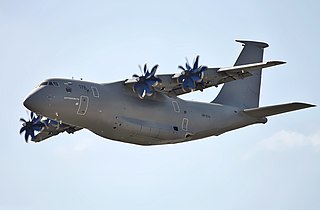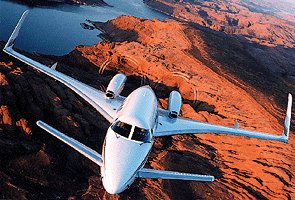
A propfan, also called an open rotor engine, open fan engine or unducted fan, is a type of aircraft engine related in concept to both the turboprop and turbofan, but distinct from both. The design is intended to offer the speed and performance of a turbofan, with the fuel economy of a turboprop. A propfan is typically designed with a large number of short, highly twisted blades, similar to the (ducted) fan in a turbofan engine. For this reason, the propfan has been variously described as an "unducted fan" (UDF) or an "ultra-high-bypass (UHB) turbofan".

The Piaggio P.180 Avanti is an executive/VIP light transport aircraft, designed by Piaggio Aero and built in Italy. It features twin, wing-mounted turboprop engines, in a pusher configuration. The Avanti seats up to nine people in a pressurized cabin and may be flown by one or two pilots. The design is of three-surface configuration, having both a small forward wing and a conventional tailplane, as well as its main wing, with the main wing spars passing behind the passenger cabin area. The FAI lists it as the fastest propeller-driven aircraft with speed of 927.4 km/h.

The Pratt & Whitney Canada PT6 is a turboprop aircraft engine produced by Pratt & Whitney Canada. Its design was started in 1958, it first ran in February 1960, first flew on 30 May 1961, entered service in 1964, and has been continuously updated since. The PT6 consists of two basic sections: a gas generator with accessory gearbox, and a free-power turbine with reduction gearbox. In aircraft, the engine is often mounted "backwards," with the intake at the rear and the exhaust at the front, so that the turbine is directly connected to the propeller. Many variants of the PT6 have been produced, not only as turboprops but also as turboshaft engines for helicopters, land vehicles, hovercraft, and boats; as auxiliary power units; and for industrial uses. By November 2015, 51,000 had been produced, which had logged 400 million flight hours from 1963 to 2016. It is known for its reliability, with an in-flight shutdown rate of 1 per 651,126 hours in 2016. The PT6A turboprop engine covers the power range between 580 and 1,940 shp, while the PT6B/C are turboshaft variants for helicopters.

The Rolls-Royce AE 2100 is a turboprop developed by Allison Engine Company, now part of Rolls-Royce North America. The engine was originally known as the GMA 2100, when Allison was a division of former corporate parent General Motors.

The Boeing 7J7 was an American short- to medium-range airliner proposed by American aircraft manufacturer Boeing in the 1980s. It would have carried 150 passengers and was touted as the successor to the successful Boeing 727. It was initially planned to enter service in 1992. This was intended as a highly fuel-efficient aircraft employing new technologies, but it was postponed indefinitely as the price of oil dropped during the 1980s.

The Beechcraft King Air is a line of American utility aircraft produced by Beechcraft. The King Air line comprises a number of twin-turboprop models that have been divided into two families. The Model 90 and 100 series developed in the 1960s are known as King Airs, while the later T-tail Model 200 and 300 series were originally marketed as Super King Airs, with the name "Super" being dropped by Beechcraft in 1996.

The Harbin Y-12 is a high wing twin-engine turboprop utility aircraft built by Harbin Aircraft Industry Group (HAIG).

The Antonov An-70 is a four-engine medium-range transport aircraft, and the first aircraft to take flight powered only by propfan engines. It was developed in the late 1980s by the Antonov Design Bureau to replace the obsolete An-12 military transport aircraft. The maiden flight of the first prototype took place in December 1994 in Kyiv, now independent Ukraine. Within months the prototype had suffered a mid-air collision. A second airframe was produced to allow the flight-test programme to proceed. Both prototypes were produced by the Kyiv Aircraft Production Plant.

The Pratt & Whitney Canada PW100 aircraft engine family is a series of 1,800 to 5,000 shaft horsepower turboprops manufactured by Pratt & Whitney Canada. Pratt & Whitney Canada dominates the turboprops market with 89% of the turboprop regional airliner installed base in 2016, leading GE Aviation and Allison Engine Company.

The Beechcraft Bonanza is an American general aviation aircraft introduced in 1947 by Beech Aircraft Corporation of Wichita, Kansas. The six-seater, single-engined aircraft is still being produced by Beechcraft and has been in continuous production longer than any other aircraft in history. More than 17,000 Bonanzas of all variants have been built, produced in both distinctive V-tail and conventional tail configurations; early conventional-tail versions were marketed as the Debonair.

The Beechcraft Model 50 Twin Bonanza is a small twin-engined aircraft designed by Beechcraft as an executive transport for the business market. It was developed to fill a gap in Beechcraft's product line between the single-engined Model 35 Bonanza and the larger Model 18. The Twin Bonanza is dissimilar to the Bonanza, being much larger and heavier and using more powerful engines, while in its earliest form having only half the passenger capacity of the Model 18.

The Beechcraft Model 17 Staggerwing is an American biplane with an atypical negative wing stagger. It first flew in 1932.

The LearAvia Lear Fan 2100 was a turboprop business aircraft designed in the 1970s, with an unusual configuration. The Lear Fan never entered production.

The Beechcraft Model 18 is a 6- to 11-seat, twin-engined, low-wing, tailwheel light aircraft manufactured by the Beech Aircraft Corporation of Wichita, Kansas. Continuously produced from 1937 to November 1969, over 9,000 were built, making it one of the world's most widely used light aircraft. Sold worldwide as a civilian executive, utility, cargo aircraft, and passenger airliner on tailwheels, nosewheels, skis, or floats, it was also used as a military aircraft.

The Beechcraft 1900 is a twin-engine turboprop regional airliner manufactured by Beechcraft. It is also used as a freight aircraft and corporate transport, and by several governmental and military organizations. With customers favoring larger regional jets, Raytheon ended production in October 2002.

The General Electric GE36 was an experimental aircraft engine, a hybrid between a turbofan and a turboprop, known as an unducted fan (UDF) or propfan. The GE36 was developed by General Electric Aircraft Engines, with its CFM International equal partner Snecma taking a 35 percent share of development. Development was cancelled in 1989.

The Hawker 4000, originally known as the Hawker Horizon, is a super-midsize business jet developed by Hawker Beechcraft.

The Progress D-27 is a three-shaft propfan engine developed by Ivchenko Progress, and manufactured by Motor Sich in Ukraine. The gas generator was designed using experience from the Lotarev D-36 turbofan. The D-27 engine was designed to power more-efficient passenger aircraft such as the abandoned Yakovlev Yak-46 project, and it was chosen for the Antonov An-70 military transport aircraft. As of 2019, the D-27 is the only contra-rotating propfan engine to enter service.

The Beechcraft Super King Air family is part of a line of twin-turboprop aircraft produced by Beechcraft. The Model 200 and Model 300 series were originally marketed as the "Super King Air" family; the "Super" designation was dropped in 1996. They form the King Air line together with the King Air Model 90 and 100 series.
The Beechcraft Heritage Museum is an aviation museum at the Tullahoma Regional Airport in Tullahoma, Tennessee. It is focused on the history of the Beech Aircraft Corporation.





















